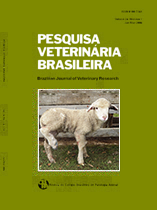 |
|
|
|
Year 2016 - Volume 36, Number 10
|

|
Aspects of spermatogenesis and microscopic testicular morphology in Greater Rhea, Rhea americana (Linnaeus, 1758), 36(10):1045-1052
|
ABSTRACT.- Freneau G.E., Carvalho S.F.M., Saboia-Morais S.M.T. & Freneau B.N. 2016. Aspects of spermatogenesis and microscopic testicular morphology in Greater Rhea, Rhea americana (Linnaeus, 1758). Pesquisa Veterinária Brasileira 36(10):1045-1052. Laboratório de Andrologia e Tecnologia do Sêmen, Escola de Veterinária e Zootecnia, Universidade Federal de Goiás, Campus Samambaia, Av. Esperança s/n, Campus Universitário, Goiânia, GO 74690-900, Brazil. E-mail: gfreneau@gmail.com
The purpose of this study was to study the microscopic morphology of the testicular parenchyma of Rhea americana birds. Fifty-four 2.5±0.5 year-old male adults bred in captivity. were used. During commercial slaughter, samples of testis were collected in November/2005, December/2006 and May/2007, in order to compare possible differences. The samples underwent optical microscopy analysis and measurements of seminiferous tubule (ST) total diameters, lumen, epithelium thickness and the relative volume of parenchyma. The ST had circular form in transverse cross sections. November/2005 and December/2006 samples had many types of germinative cells and spermatozoa in lumen, but in May/2007 the samples of epithelium were poor regarding meiotic and mitotic pictures, and it was difficult to find any spermatozoon; in many tubules the lumen was inexistent or diminished. In December/2006 and May/2007 the averages were: tubule diameter 110.3 and 5.3mµ, lumen 52.4 and 4.5mµ, epithelium thickness 57.8 and 0.7mµ respectively. The volumetric proportions were: seminiferous epithelium 75.6 and 75.9, cysts in epithelium 2.1 and 1.0, ST 93.3 and 84.0, interstitium 6.2 and 15.6 respectively. The sperm reserves were: 19.7±2 and 0±0 x109 sperm cells in December 2006 and May 2007 respectively. Microscopic measures of seminiferous tubules, spermatic cells and diameter of the nuclei were presented. These data confirm reproductive seasonality, with breeding season in spring-summer with sperm production. A great variation n parenchyma, when compared breeding was noticeable. |
| |
|
|
| |
|
 |